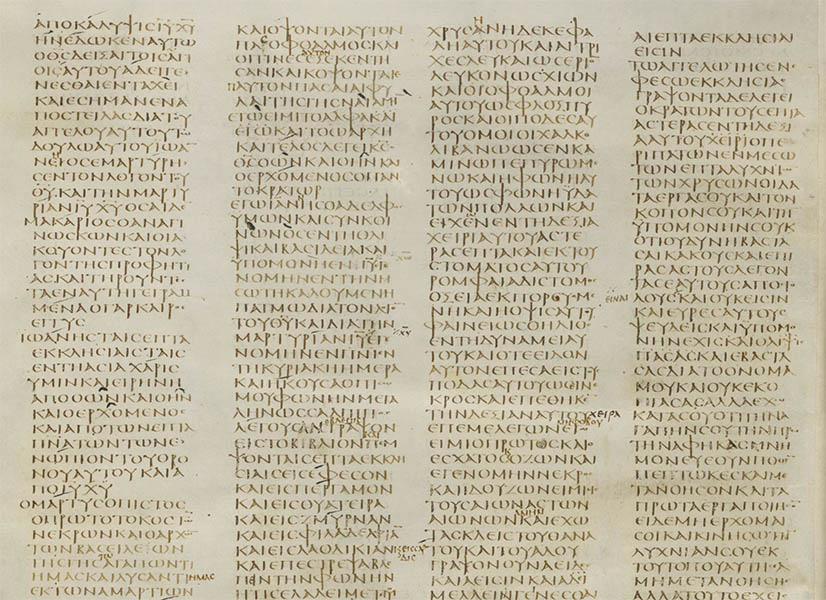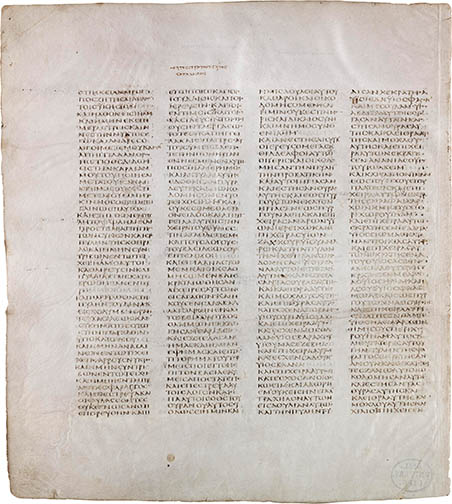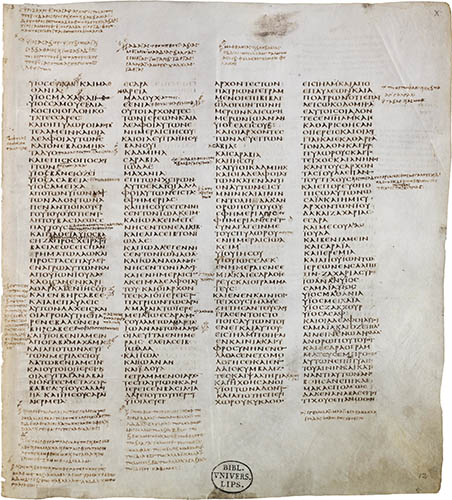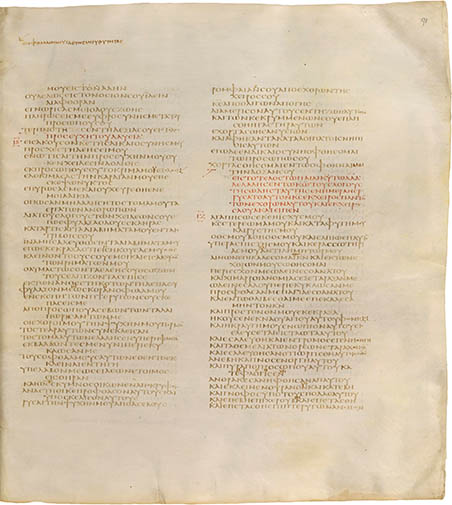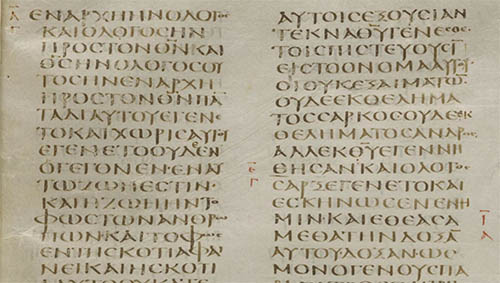23
The Codex Sinaiticus
The Book
This is the beginning of Apocolypse (αποκαλυψιϲ ιυ χυ...)1 from the Codex Sinaiticus (AKA the Codex Frederico-Augustanus or the Codex Sinaiticus Petropolitanus.) The Codex is the second oldest extant version of the Bible and is not only a critically important manuscript in the history of literary criticism, but also in the history of the Western book and typography in general.
In 1844, when the German biblical scholar Constantin Tischendorf was scouring the middle-east in search of ancient manuscripts for Frederick Augustus, King of Saxony, he came across a number of leaves he recognized as a Koine Greek version of the Septuagint in the library of St. Catherines monastery at the foot of Mt. Sinai. Leaves that he claimed were “rubbish which was to be destroyed by burning it in the ovens of the monastery.”2 In his excitement he apparently alerted the monks to their value and he left with only some of manuscript.
Tischendorf returned to St. Catherines in 1853 for the rest, but left empty-handed. He visited a third time in 1859, this time under the patronage of Czar Alexander II, but it appeared that again he would be unsuccessful. On his last day at the monastery a monk showed him not only the leaves he had seen before, but more of the manuscript – almost the complete bible. Through either good-willed negotiations or Indiana Jones level duplicity (accounts vary, depending on whom you ask) he was finally able to obtain the entire manuscript for the czar in St. Petersburg.
Between 1907–1911, Vladimir Beneshevich, Byzantine scholar, recovered three more leaves from the bindings of other books in the monastery’s library. In 1933 the Russian National Library, apparently having little use for an old bible, sold their portion of the manuscript to the British Library and, finally, in 1975, during restoration work at the monastery 11 additional leaves were found. So today the extant manuscript is divided between the British library (347 leaves), the Leipzig University library (43 leaves), St. Catherines monastery (11 leaves and 24 fragments) and the Russian National library (3 leaves).3
The Codex was written sometime between 330–360 AD. Scholars disagree on its origin; it may have been written in Rome, Alexandria, or Caesarea, and it may have been one of the fifty copies of the Bible commissioned from Eusebius by Roman Emperor Constantine after his conversion to Christianity. Whatever its origin, however, it is, along with the similar Codex Vaticanus,4 the earliest witness of the Septuagint and the New Testament. 4
The text was written in uncial Koine Greek in a form known as scripto continua by three (or four) different scribes and annotated through the centuries by no less than nine correctors. Each page has four identical columns of 48 lines (except Psalms, which, based on the Greek stichometric measure of στίχοι, are 2 columns per page). It is clear that there was some thought to the page layout. The vellum pages measure 38.1 cm × 34.5 cm (a 1.1:1 ratio) and the text block measures the reciprocal (1:1.1 or 0.91); a design that the poet-typographer Bringhurst describes as "a subtle piece of craftsmanship."5 It is, for all practical purposes, the earliest example of a book.
2 Esdras, 12:10–13:13. Quire 35, folio 6, verso
The super-annotated 2 Esdras, 21:15–22:37. Quire 36, folio 4, recto
Psalms, 15:10–17:11. Quire 59, folio 4, recto
High-res detail, John 1:1. Quire 80, folio 1, recto
Writing on animal skins goes back well into antiquity. Heroditus mentions it as a common practice during the fifth century BC (Histories, V58), but Pliny, in Naturalis Historia, credits the invention of parchment to Eumenes II in Pergamon, around 190 BC. At the time Ptolemy in Alexandria and Eumenes were in a library-building rivalry so fierce that Ptolemy embargoed shipments of papyrus to Pergamon to prevent Eumenes from writing any more scrolls. Eumenes response was to invent parchment as a replacement.
Because parchment was so expensive the scribes had to use both sides of the sheet and they had to develop a new format to accommodate this – the codex. The codex consisted of individual folios folded into gatherings or quires (a signature in modern terms) which were sewn together into a codex. Essentially the same process as the present-day book. The physical advantages of the codex over the scroll are obvious but it wasn’t until the early Christians adopted the format to differentiate their God-inspired writings from the pagan scrolls that the codex became widely used. By the fourth century AD the codex had became the dominant written format in the West.
1. αποκαλυψιϲ ιυ χυ ην εδωκεν αυτω ο θϲ δειξαι τοιϲ αγι οιϲ αυτου α δει γε> νεϲθαι εν ταχει και εϲημανεν α ποϲτειλαϲ δια του αγγελου αυτου τω δουλω αυτου ϊωα (The revelation of Jesus Christ, which God gave to him, to show to his servants things that must shortly take place, and having sent by his angel he made it known to his servant John.). The manuscript is considered an Alexandrian text-type, and is categorized by Gregory-Aland as א or 01, or by Soden as δ 2.
2. Although this was probably a fabrication on the part of Tischendorf. In 1863 Rev. J. Silvester Davies quoted “a monk of Sinai who... stated that according to the librarian of the monastery the whole of Codex Sinaiticus had been in the library for many years and was marked in the ancient catalogues,” making it highly unlikely that they threw it away. It was also noted that the leaves were in suspiciously good condition for something pulled out of a trash can.
3. In 2005 the four holding institutions agreed to present the entire manuscript on the internet and theproject was completed in Jul 2009. The Codex Sinaiticus Project includes not only multiple only high-resolution images of the individual leaves, but a complete translation of the text. The project is one of the best uses of the internet your humble author is aware of. Note that the images in this post are from reassembled screen captures from the site.
4. The Codex Vaticanus, considered slightly older than the Sinaiticus, is written in three columns with 42 lines per column (execpt for Psalms which, again due to stichometric considerations, is two columns). Shown here is a leaf containing the end of 2 Thessolonians and the beginning of Hebrews (note that the rubication was added much later):
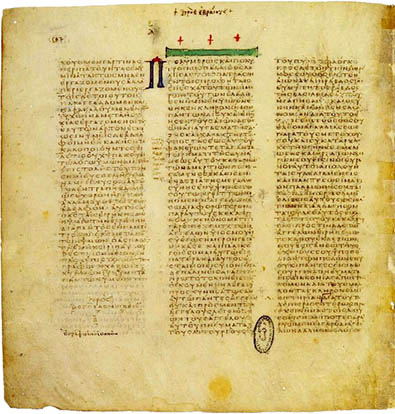
5. Bringhurst, Robert. The Elements of Typographic Style. Vancouver: Hartley & Marks. 1993.
28 Mar 2009, updated 30 Dec 2011 ‧ Typographia Historia
